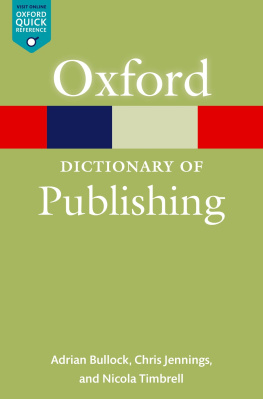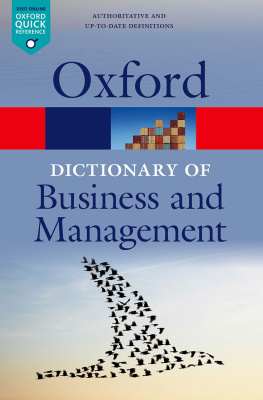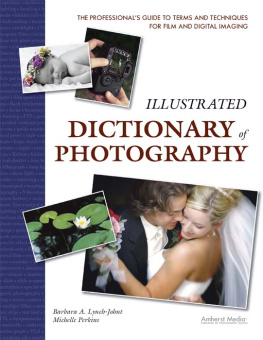How to search for terms in
A Dictionary of Publishing
To find an entry in this e-book you can:
Browse the and select the entry you would like to view
or
Use your Search function to be taken to a complete list of references to your search term in the
DictionaryIf your search term has its own entry, it will usually be listed at the top of your results
In cases where your search term appears in more than one entry heading, the results will be listed alphabetically
A note on special characters
While most e-readers can display special characters (such as and ), many cannot search for words containing them, unless the special characters themselves are typed into the search box. If you are unable to type these characters, please browse for your term using the .
A DICTIONARY OF PUBLISHING

Great Clarendon Street, Oxford, ox2 6dp, United Kingdom
Oxford University Press is a department of the University of Oxford. It furthers the Universitys objective of excellence in research, scholarship, and education by publishing worldwide. Oxford is a registered trade mark of Oxford University Press in the UK and in certain other countries
Oxford University Press 2019
The moral rights of the authors have been asserted
First edition 2019
All rights reserved. No part of this publication may be reproduced, stored in a retrieval system, or transmitted, in any form or by any means, without the prior permission in writing of Oxford University Press, or as expressly permitted by law, by licence or under terms agreed with the appropriate reprographics rights organization. Enquiries concerning reproduction outside the scope of the above should be sent to the Rights Department, Oxford University Press, at the address above
You must not circulate this work in any other form and you must impose this same condition on any acquirer
Published in the United States of America by Oxford University Press 198 Madison Avenue, New York, NY 10016, United States of America
British Library Cataloguing in Publication Data
Data available
Library of Congress Cataloging in Publication Data
Data available
eISBN 9780191863592
ebook ISBN 9780192558473
CONTENTS
Sir Stanley Unwin, in the introduction to the fourth edition of his book The Truth About Publishing, wrote:
Publishing is quite different from what most people apparently suppose . It is not a profession, it is at once an art, a craft, and a business . [T]he publishers task is no simple one; the whole process of book publication is vastly more complicated than it was even a generation ago. It is more exacting and calls for technical knowledge of a wider range than heretofore, and for a higher standard of efficiency.
That was in 1946. Since then, the use of digital technology in the twenty-first century has changed, and continues to change, virtually beyond all recognition, the way content is created, produced, distributed, sold, and consumedin short, the way publishing works. Terms and concepts, as familiar to Unwin in 1946 as to someone working in publishing in 1996, two generations later, have now all but disappeared as functions and processes have become obsolete or redundant and are replaced by new ways of thinking and doing things. The pace of change has never been faster, and there is little sign of it slowing down.
The publishing industry does not often write about itself, and much of what is written can be narrow in scope as it deals with a specific issue or topic, which can quickly lose its value and currency. There is, therefore, a perceived need for an authoritative and broad-scoped body of content that is able to provide someone interested in, someone studying, or someone working in publishing today with easy access to an understanding of how the publishing industry operates at the beginning of the twenty-first century.
The QR Dictionary of Publishing has been compiled to fill this gap; and, because it is an online product, it lends itself readily to updates and additions at regular intervals that will maintain its relevance and future-proof it for generations to come.
The dictionary contains more than 260 entries covering the wide range of aspects, functions, processes, concepts, and products that, taken together, provide the user with a comprehensive and comprehensible view of contemporary publishing.
Authorship
Business and finance
Design
Digital
Distribution and bookselling
Editorial
Environmental
Legal
Printing and binding
Production and manufacture
Sales and marketing
Sector or genre
Typography
Workflow
The publishing sector whose main aim is to ensure accurate dissemination of advances in learning is known as academic or scholarly publishing. This sector, unlike others, uses peer review or editorial refereeing by experts in the subject to select and approve material for publication. Academic publishers include for-profit publishers, associations and societies, and university presses.
Traditionally academic research work was published in a print publishing.
.
.
; aggregation in A Dictionary of Journalism.
has been made possible by the ability to push content out through websites. The term is also used in the news industry, where an organization will package news articles from more than one news source; they would not normally be creating their own content. See also aggregator in A Dictionary of Marketing.
A method of managing projects, most commonly those of a digital nature. The term was originally used by software developers as they sought to find a way to produce working software for their customers quickly and efficiently. Agile methods allow rapid response to change during the lifetime of the project, meaning that goals and milestones can potentially be fluid and be respecified as the project develops.
In publishing this can mean approaching product development with a more open-ended proposition, or building products and services that might change as circumstances develop. It may mean reusing content on more than one platform and making sure that assets and legacy content will be available for new platforms as technology provides them. In agile methodology customer involvement is extremely important throughout the project lifecycle. The publisher will ensure the customers needs are met and ask them to provide feedback on the use of the product as the development proceeds.
( advanced information sheet ) A sheet created to provide marketing details before a book is published and ready for distribution. This sheet is often no larger than A4, but includes biographical information, a blurb, and even sample illustrations. Sometimes the design of the book cover is also provided.
Some publishers use the design of the jacket together with its back and flaps as an early announcement of the book before it is published. This latter might be regarded as a simple .
; Amazon.com in A Dictionary of Marketing.
A tool that helps a publishing business visualize its current product offering and market, and consider strategy for future growth. It is named after Harry Igor Ansoff, who is known as the father of strategic management.
The matrix or grid gives four possible routes to growth and the risks associated with them. Risk is said to increase as one moves into another quadrant either horizontally or vertically.












